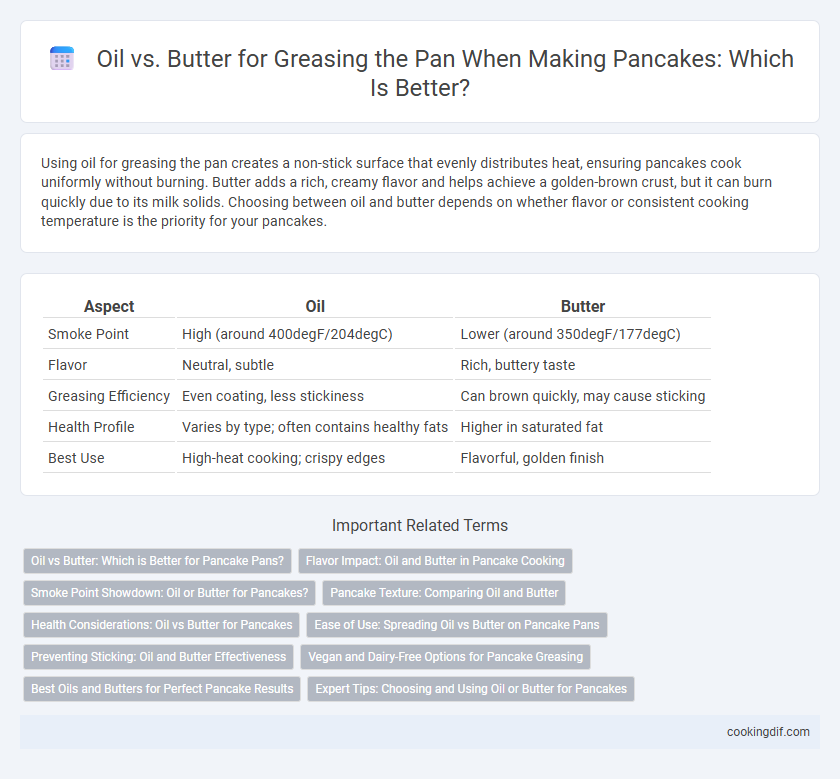Using oil for greasing the pan creates a non-stick surface that evenly distributes heat, ensuring pancakes cook uniformly without burning. Butter adds a rich, creamy flavor and helps achieve a golden-brown crust, but it can burn quickly due to its milk solids. Choosing between oil and butter depends on whether flavor or consistent cooking temperature is the priority for your pancakes.
Table of Comparison
| Aspect | Oil | Butter |
|---|---|---|
| Smoke Point | High (around 400degF/204degC) | Lower (around 350degF/177degC) |
| Flavor | Neutral, subtle | Rich, buttery taste |
| Greasing Efficiency | Even coating, less stickiness | Can brown quickly, may cause sticking |
| Health Profile | Varies by type; often contains healthy fats | Higher in saturated fat |
| Best Use | High-heat cooking; crispy edges | Flavorful, golden finish |
Oil vs Butter: Which is Better for Pancake Pans?
Oil provides a higher smoke point than butter, making it less likely to burn and create a bitter taste when greasing pancake pans. Butter offers a rich flavor and helps achieve a golden-brown crust but requires careful temperature control to prevent scorching. For optimal pancake texture and taste, many chefs prefer using a combination of oil and butter to balance flavor and heat resistance.
Flavor Impact: Oil and Butter in Pancake Cooking
Butter imparts a rich, creamy flavor to pancakes, enhancing their taste with a slightly nutty and caramelized edge when browned in the pan. Oil, such as vegetable or canola oil, offers a neutral flavor that allows the natural sweetness of the pancake batter to shine without added richness. Choosing butter or oil for greasing directly influences the pancake's flavor profile, with butter providing depth and oil maintaining a lighter taste.
Smoke Point Showdown: Oil or Butter for Pancakes?
Choosing between oil and butter for greasing the pan when making pancakes revolves around their smoke points; oils like canola or vegetable oil have higher smoke points around 400degF, resisting burning and maintaining flavor integrity during cooking. Butter, with a lower smoke point around 350degF, offers rich flavor and browns quickly but can burn, imparting a bitter taste and dark spots on pancakes if overheated. Balancing heat to prevent butter from smoking or opting for oils with high smoke points ensures golden, evenly cooked pancakes with optimal texture and taste.
Pancake Texture: Comparing Oil and Butter
Using butter to grease the pan imparts a rich, creamy flavor and creates a slightly crispy edge, enhancing the pancake's overall texture. Oil, especially neutral oils like vegetable or canola, promotes even cooking and results in a soft, tender pancake without the risk of burning. Butter's milk solids can brown and add a nutty taste, while oil provides a smoother surface, influencing the pancake's golden color and moisture retention.
Health Considerations: Oil vs Butter for Pancakes
Using oil for greasing pancake pans offers a heart-healthier option due to its higher unsaturated fat content and lower saturated fat compared to butter, reducing the risk of cholesterol-related issues. Butter provides rich flavor but contains higher levels of saturated fats and cholesterol, which can contribute to cardiovascular concerns if consumed excessively. Opting for oils like olive or avocado oil enhances the nutritional profile of pancakes by supplying essential fatty acids and antioxidants while maintaining non-stick properties.
Ease of Use: Spreading Oil vs Butter on Pancake Pans
Oil provides a smoother and quicker application on pancake pans, ensuring an even non-stick surface without clumping. Butter requires time to melt and can spread unevenly, making it less efficient during busy cooking sessions. For ease of use, oil's liquid form allows consistent coverage and faster preparation.
Preventing Sticking: Oil and Butter Effectiveness
Using oil for greasing the pan provides a higher smoke point, making it more effective at preventing pancake sticking by creating a stable, non-stick surface during cooking. Butter offers rich flavor and browning but can burn quickly, increasing the risk of pancakes sticking if the heat is too high. For optimal non-stick results, a light coating of oil ensures even heat distribution and less residue buildup, while butter enhances taste but requires careful temperature control to avoid sticking.
Vegan and Dairy-Free Options for Pancake Greasing
Using plant-based oils such as coconut oil, avocado oil, or light olive oil provides excellent vegan and dairy-free options for greasing pancake pans without compromising flavor or texture. These oils have high smoke points, ensuring even cooking and preventing sticking while maintaining a neutral or subtly enhancing taste. Choosing oils over butter eliminates dairy concerns and caters to vegan diets, promoting healthier and allergen-free breakfast preparations.
Best Oils and Butters for Perfect Pancake Results
Choosing the best oils and butters for greasing the pan significantly impacts pancake texture and flavor. High smoke point oils like canola, vegetable, and refined sunflower oil prevent burning while providing a neutral taste, whereas clarified butter (ghee) offers a rich, nutty flavor without the risk of browning too quickly. Combining oil with a small amount of unsalted butter can yield perfectly golden, fluffy pancakes with a balanced buttery aroma.
Expert Tips: Choosing and Using Oil or Butter for Pancakes
Choose oil with a high smoke point like canola or vegetable oil for even cooking and crisp edges when greasing your pan for pancakes. Butter adds rich flavor and promotes browning but can burn quickly, so use clarified butter or combine it with oil to prevent scorching. Expert tips recommend lightly coating the pan to avoid excessive grease absorption, ensuring perfectly golden pancakes with a tender interior.
Oil vs butter for greasing the pan Infographic

 cookingdif.com
cookingdif.com